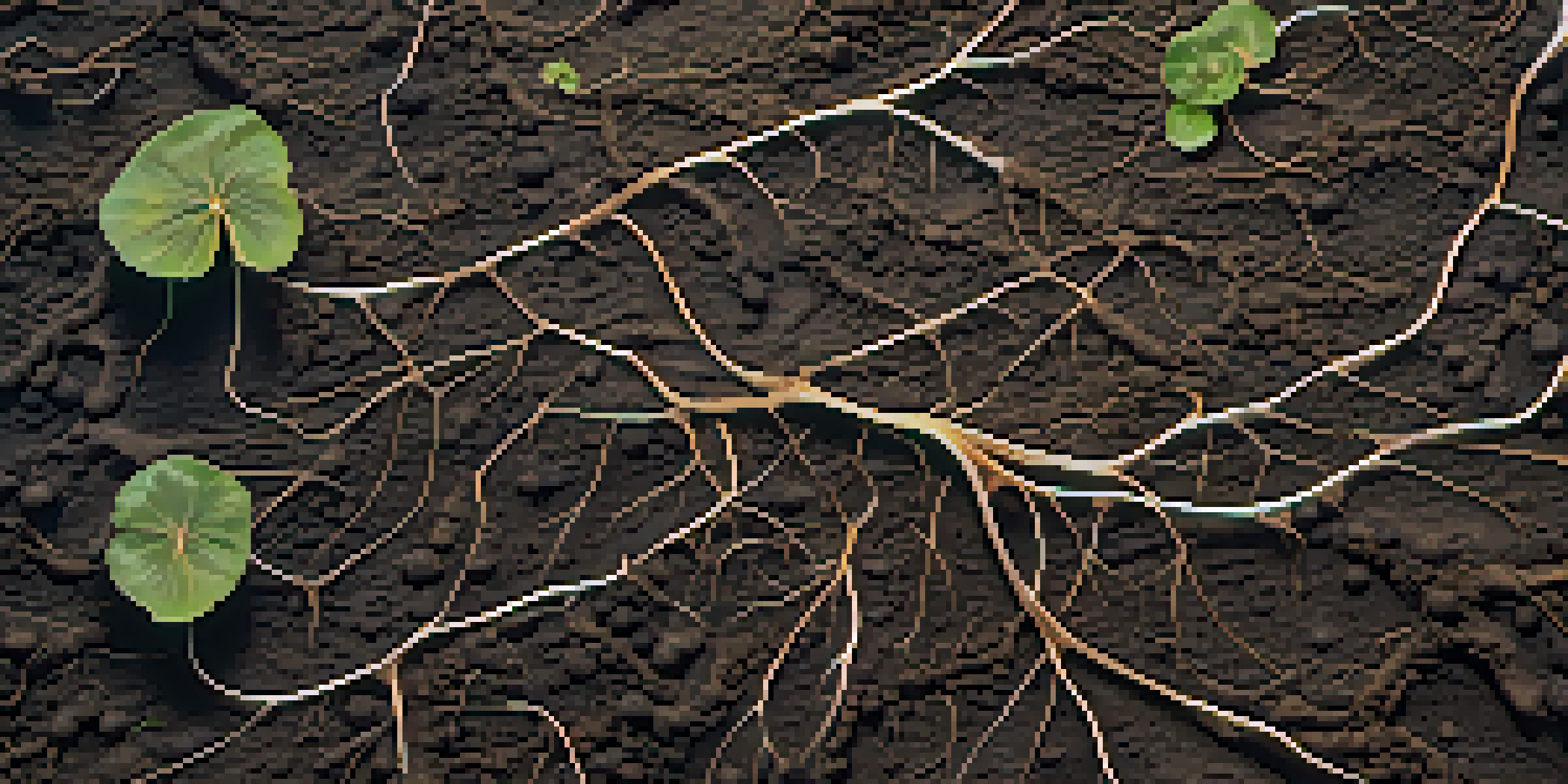The Symbiotic Link: Mycorrhizal Fungi and Plant Health

Understanding Mycorrhizal Fungi and Their Role
Mycorrhizal fungi are fascinating organisms that form partnerships with plant roots. These relationships can be likened to a friendship where both parties benefit. The fungi enhance nutrient absorption, particularly phosphorus, while plants provide carbohydrates in return. This mutualistic interaction is crucial for plant health and growth, making mycorrhizal fungi essential players in ecosystems.
The soil is a living entity, and mycorrhizal fungi are its vital arteries.
There are two main types of mycorrhizal fungi: arbuscular mycorrhizal (AM) fungi and ectomycorrhizal (ECM) fungi. AM fungi penetrate the root cells, while ECM fungi form a sheath around the roots. Each type has its unique benefits and host plant preferences, which allows for a diverse range of plants to thrive. Ultimately, these fungi help create a robust and interconnected underground network.
The importance of mycorrhizal fungi extends beyond individual plants; they contribute to soil health and ecosystem stability. By enhancing soil structure and nutrient availability, these fungi play a vital role in supporting biodiversity. Without mycorrhizal relationships, many plants would struggle to survive, highlighting the intricate web of life in our natural world.
How Mycorrhizal Fungi Improve Plant Nutrient Uptake
One of the most significant benefits of mycorrhizal fungi is their ability to improve nutrient uptake for plants. They extend the root system's reach, accessing nutrients and water that would otherwise be unavailable. This is particularly important in nutrient-poor soils, where plants can struggle to find essential elements for growth.

For instance, phosphorus is often a limiting nutrient in many soils. Mycorrhizal fungi excel at solubilizing phosphorus, making it more accessible to plants. This enhanced nutrient uptake can lead to healthier, more vigorous plants that are better equipped to withstand environmental stressors, such as drought or disease.
Mycorrhizal Fungi Enhance Growth
These fungi improve nutrient uptake and plant vigor, allowing plants to thrive even in challenging conditions.
Additionally, mycorrhizal fungi can help plants access micronutrients like zinc and copper, which are vital for various physiological processes. By improving nutrient availability, these fungi not only support individual plant health but also contribute to overall ecosystem productivity and resilience.
The Impact of Mycorrhizal Fungi on Plant Diversity
Mycorrhizal fungi play a crucial role in promoting plant diversity within ecosystems. By supporting various plant species, they help maintain a balanced and resilient ecosystem. This diversity is important because different plants can contribute to soil health and resilience in unique ways.
In nature, nothing exists alone. Mycorrhizal fungi exemplify the interconnectedness of life.
For example, in a mixed plant community, some species might thrive better with specific types of mycorrhizal fungi. This can lead to a more diverse range of plants, which in turn supports a wider array of wildlife. Healthy ecosystems with diverse plant life are more likely to recover from disturbances, such as pests or climate changes.
Moreover, diverse plant communities can enhance nutrient cycling and soil structure. With different root systems and growth habits, these plants can utilize resources more efficiently, benefiting the entire ecosystem. Mycorrhizal fungi, therefore, act as facilitators of this diversity, creating a thriving environment for all life forms.
Mycorrhizal Fungi and Plant Stress Resistance
Plants with mycorrhizal associations often exhibit increased resistance to various stresses. This includes drought, salinity, and diseases. The enhanced nutrient uptake provided by mycorrhizal fungi strengthens plant vigor, enabling them to better cope with challenging conditions.
For instance, during prolonged dry spells, mycorrhizal fungi can help plants access deeper soil moisture. This advantage allows plants to survive longer during drought conditions, giving them a greater chance to thrive when rain returns. Additionally, some studies suggest that these fungi can boost a plant's immune response, making them less susceptible to pathogens.
Boosting Plant Diversity
Mycorrhizal fungi support various plant species, which helps maintain a balanced and resilient ecosystem.
Furthermore, the protective benefits of mycorrhizal fungi extend to soil health as well. By promoting healthier root systems and enhancing soil structure, these fungi help create an environment less conducive to diseases. As a result, plants in mycorrhizal partnerships often exhibit improved overall health and resilience.
The Role of Mycorrhizal Fungi in Carbon Sequestration
Mycorrhizal fungi are also significant players in carbon sequestration efforts. Through their interactions with plant roots, they help store carbon in the soil, which is vital for combating climate change. This process occurs as plants photosynthesize and transfer carbon to their roots, where mycorrhizal fungi facilitate its storage in the form of organic matter.
By forming stable aggregates in the soil, mycorrhizal fungi contribute to long-term carbon storage. This not only helps mitigate greenhouse gas emissions but also improves soil health and fertility. Healthier soils can store even more carbon, creating a positive feedback loop that benefits both agriculture and natural ecosystems.
Additionally, as climate change intensifies, understanding the role of mycorrhizal fungi in carbon cycling becomes increasingly important. Their ability to enhance plant growth and soil health can be leveraged in land management practices, helping to create more sustainable agricultural systems that support our planet's health.
Cultivating Mycorrhizal Fungi in Agriculture
In agriculture, harnessing the power of mycorrhizal fungi can lead to healthier crops and increased yields. Farmers can enhance soil microbial communities by implementing practices that support these beneficial fungi. For instance, reducing chemical fertilizers and pesticides can create a more conducive environment for mycorrhizal growth.
Cover cropping is another effective strategy that can promote mycorrhizal fungi. By planting diverse cover crops, farmers can improve soil structure and nutrient cycling, fostering beneficial fungi in the process. This not only boosts crop health but also enhances soil resilience against erosion and nutrient depletion.
Key Role in Carbon Sequestration
Through their interactions with plants, mycorrhizal fungi aid in carbon storage, contributing to climate change mitigation.
Additionally, there are commercial mycorrhizal inoculants available that can be introduced to improve soil health. These products aim to enhance existing mycorrhizal populations, potentially leading to better crop performance. As more farmers recognize the advantages of these fungi, sustainable agricultural practices can become more widespread.
The Future of Mycorrhizal Research and Applications
Research on mycorrhizal fungi is rapidly evolving, revealing new insights into their vital roles in ecosystems. Scientists are exploring their potential in areas like sustainable agriculture, reforestation, and soil restoration. The more we understand these fungi, the better we can harness their benefits for both natural and agricultural systems.
One exciting area of research focuses on the specific interactions between different plant species and mycorrhizal fungi. By identifying the best combinations, we could optimize plant health and productivity in various settings, from farms to urban gardens. This knowledge could lead to tailored solutions for improving crop yields while promoting biodiversity.

As the challenges of climate change and food security grow, the importance of mycorrhizal fungi will only increase. Their ability to enhance plant resilience, improve soil health, and sequester carbon makes them indispensable allies in our efforts to create a more sustainable future. Investing in mycorrhizal research could yield significant returns for agriculture and ecological health.